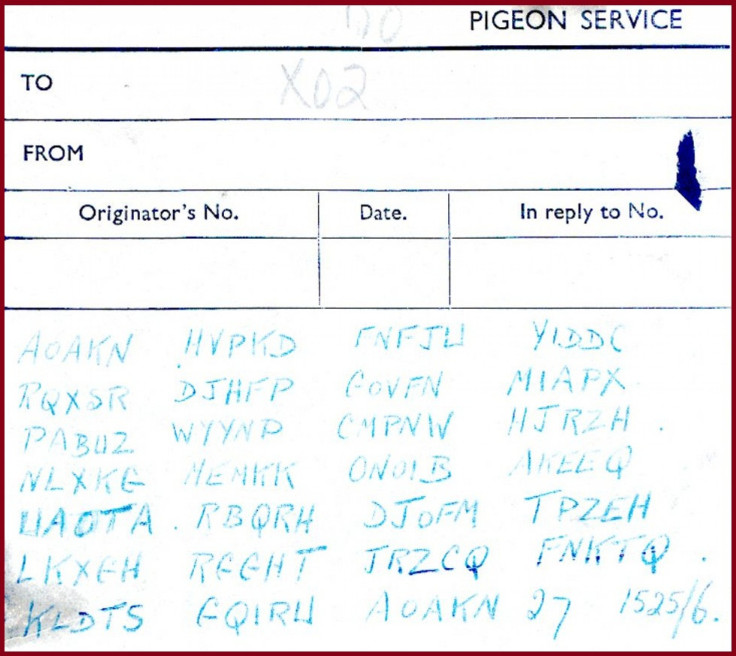World War II Message Found On Dead Carrier Pigeon Puzzles Code Breakers

The top code breakers from GCHQ, Britain’s most elite secret intelligence service, failed to crack a coded World War II message found attached to the leg of a dead carrier pigeon, and they now seek the help of retired spies and the public.
The remains of the pigeon were found in a chimney at a house in Bletchingley, Surrey, in England, when the owner of the house was renovating his 17th century house.
David Martin found the bones of the dead carrier pigeon, along with a red canister attached to the one of the bird's leg bones. The canister contained a small piece of paper labeled “Pigeon Service.” The paper had a series of handwritten letters on it, allegedly a coded message sent to the allied forces during the World War II.
The message in the paper has 27 coded words, with each containing five alphabets. Modern-day code-breakers in UK intelligence tried their best to decipher the meaning, but they failed to decode it, according to a Sky News report.
The coded letters, starting with “AOAKN,” make no sense to casual readers. Experts have identified the name of the pigeon as “40TW194” from a small aluminum ring found attached to its leg. The first two letters indicate the year of birth of the pigeon.
However, three crucial pieces of information -- the date of the message, its destination and its sender -- are missing, making it difficult to decode the encryption.
Experts believe the pigeon was flying back to Bletchley Park from France on June 6, 1944. It might have rested on the chimney due to exhaustion and got stuck in the fireplace.
Pigeons were widely used for wartime communication during that period, and most of the messages were secured with multiple encryptions, and using different methods.
According to the GCHQ, the message is probably encoded with a codebook or one-time pad encoding system that was prevalent during the time, and deciphering it may require the same code book.
"Without access to the relevant codebooks and details of any additional encryption used, it will remain impossible to decrypt," the intelligence agency said.
The complexity of the code stumped the intelligence agency, which admitted that the code appeared unbreakable.
“Although it is disappointing that we cannot yet read the message brought back by a brave carrier pigeon, it is a tribute to the skills of the wartime code-makers that, despite working under severe pressure, they devised a code that was indecipherable both then and now,” a GCHQ spokesman said.
The experts believe that the message which the pigeon carried might be a top secret considering the strength of its encryption.
“The message Mr. Martin found must be highly top secret. We have more than 30 messages from Second World War carrier pigeons in our exhibition, but not one is in code. We know it’s an Allied forces pigeon because of the red capsule it was carrying, but that’s all we know,” said Colin Hill, curator of Bletchley Park’s Pigeons at War exhibition, Scotsman News reported.
The spy agency is trying to identify the sender and addressee -- mentioned as "Sjt W Stot" and “X02” in the message -- for clues to decode the message.
The Royal Air Force trained 250,000 birds for the National Pigeon Service, and the services of these “secret agents” were widely used in various divisions of the military to pass secret messages.
© Copyright IBTimes 2024. All rights reserved.






















